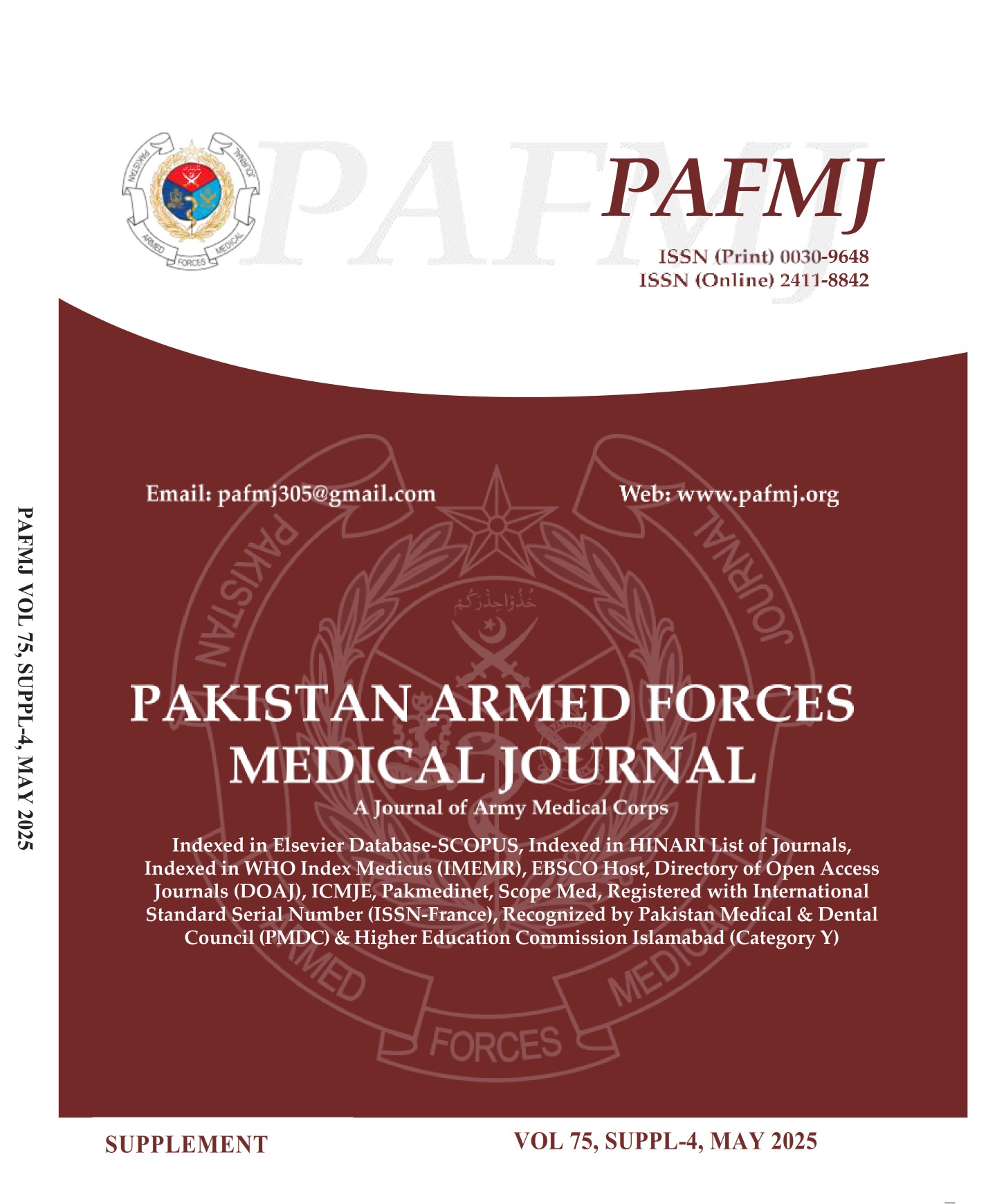Comparison of Therapeutic Efficacy of Topical Tacrolimus 0.1% and Topical Dithranol 0.5% in Treatment of Alopecia Areata
DOI:
https://doi.org/10.51253/pafmj.v75iSUPPL-4.5937Keywords:
Alopecia areata, Anthralin, Tacrolimus.Abstract
Objective: To compare the therapeutic efficacy of topical Tacrolimus 0.1% and topical Dithranol 0.5% in patients of alopecia areata.
Study Design: Quasi Experimental Study
Place and Duration of Study: Departments of Dermatology, Combined Military Hospital, Hyderabad and Combined Military Hospital, Abbottabad from Sep 2019-2020.
Methodology: Patients fulfilling the inclusion criteria were selected in the first 1 and a half months, after written informed consent. The patients were divided into two Groups A and B, by lottery method. Group A received topical Tacrolimus 0.1% application twice a day and Group B received topical Dithranol 0.5% application twice a day, for 24 weeks. The response of treatment was calculated by two observers and each of them determined the percentage of hair re growth by comparing the pre and post treatment photographs of the patient at 24 weeks.
Results: More than 80% Hair re - growth was observed in 7(23.33%) of the patients in Tacrolimus Group and 12(40%) of the patients in Dithranol Group. Therapeutic efficacy of Dithranol was more than Tacrolimus as their comparison revealed p value=0.039.
Conclusion: Therapeutic efficacy of Dithranol is superior to Tacrolimus in treatment of alopecia areata.
Downloads
References
View of Efficacy of topical Tacrolimus 0.1% and clobetasol propionate 0.05% in the treatment of alopecia areata. (2025). Jpad.com.pk. https://www.jpad.com.pk/index.php/jpad/article/view/109/90
Kuldeep CM, Singhal H, Khare AK, Mittal A, Gupta LK, Garg A. Randomized comparison of topical betamethasone valerate foam, intralesional triamcinolone acetonide and Tacrolimus ointment in management of localized alopecia areata. Int J Trichology. 2011; 3(1): 20–4.
https://doi:10.4103/0974-7753.82123
Alkhalifah A. Alopecia areata update. Dermatol Clin. 2013; 31(1): 93–108. https://doi:10.1016/j.det.2012.08.010
Alzolibani AA. Epidemiologic and genetic characteristics of alopecia areata (part 1). Acta Dermatovenerol Alp Panonica Adriat. 2011; 20(4): 191–8. Available from: https://acta-apa.mf.uni-lj.si/journals/acta-dermatovenerol-apa/papers/10.15570/archive/acta-apa-11-4/2.pdf
Ejaz A, Jameel K, Suhail M. Pattern and profile of alopecia areata in Pakistan. J Pak Assoc Dermatol. 2009; 19(3): 136–40. Available from: https://www.jpad.com.pk/index.php/jpad/article/view/529
Miteva M, Tosti A. Treatment options for alopecia: an update, looking to the future. Expert Opin Pharmacother. 2012; 13(9): 1271–8. https://doi:10.1517/14656566.2012.685160
Hunter N, Shaker O, Marei N. Diphencyprone and topical Tacrolimus as two topical immunotherapeutic modalities: are they effective in the treatment of alopecia areata among Egyptian patients? A study using CD4, CD8 and MHC II as markers. J Dermatolog Treat. 2011; 22(1): 2–10. https://doi:10.3109/09546630903410182
Miroux C, Morales O, Ghazal K, Othman SB, de Launoit Y, Pancré V, et al. In vitro effects of cyclosporine A and Tacrolimus on regulatory T-cell proliferation and function. Transplantation. 2012; 94(2): 123–31. https://doi:10.1097/TP.0b013e3182590d8f
Alkhalifah A, Alsantali A, Wang E, McElwee KJ, Shapiro J. Alopecia areata update: part II. Treatment. J Am Acad Dermatol. 2010; 62(2): 191–202. https://doi:10.1016/j.jaad.2009.10.031
Sasmaz S, Arican O. Comparison of azelaic acid and anthralin for the therapy of patchy alopecia areata: a pilot study. Am J Clin Dermatol. 2005; 6(6): 403–6.
https://doi:10.2165/00128071-200506060-00007
Fuchs E. Scratching the surface of skin development. Nature. 2007; 445(7130): 834–42. https://doi:10.1038/nature05659
Rooks. Burns T, Breathnach S, Cox N, Griffiths C, editors. Rook’s Textbook of Dermatology. 8th ed. Oxford: Wiley-Blackwell; 2010.
Thibaut S, Barbarat P, Leroy F, Bernard BA. Human hair keratin network and curvature. Int J Dermatol. 2007; 46(Suppl. 1): 7–10. https://doi:10.1111/j.1365-4632.2007.03454.x
Pinkus H. Embryology of hair. In: Montagna W, Ellis RA, editors. The Biology of Hair Growth. New York: Academic Press; 1958. p. 1–32. https://doi:10.1016/S0733-8635(18)30728-9
Szabo G. The regional anatomy of the human integument with special reference to the distribution of hair follicles, sweat glands and melanocytes. Philos Trans R Soc Lond B Biol Sci. 1967; 252(776): 447–85. https://doi:10.1098/rstb.1967.0029
Birch MP, Messenger JF, Messenger AG. Hair density, hair diameter and the prevalence of female pattern hair loss. Br J Dermatol. 2001; 144(2): 297–304.
https://doi:10.1046/j.1365-2133.2001.04018.x
Narisawa Y, Kohda H. Arrector pili muscles surround human facial vellus hair follicles. Br J Dermatol. 1993; 129(1): 138–9. https://doi:10.1111/j.1365-2133.1993.tb03515.x
Oliver RF. Whisker growth after removal of the dermal papilla and lengths of follicle in the hooded rat. J Embryol Exp Morphol. 1966; 16: 231–44.
Oliver RF. The experimental induction of whisker growth in the hooded rat by implantation of dermal papillae. J Embryol Exp Morphol. 1967; 18: 43–51.
Oliver RF. The induction of hair follicle formation in the adult hooded rat by vibrissa dermal papillae. J Embryol Exp Morphol. 1970; 23: 219–36.
Jahoda CA, Horne KA, Oliver RF. Induction of hair growth by implantation of cultured dermal papilla cells. Nature. 1984; 311(5986): 560–2.
https://doi:10.1038/311560a0
Reynolds AJ, Lawrence C, Cserhalmi-Friedman PB, et al. Trans-gender induction of hair follicles. Nature. 1999; 402(6757): 33–4. https://doi:10.1038/46938
Langbein L, Rogers MA, Winter H, et al. The catalog of human hair keratins. I. Expression of the nine type I members in the hair follicle. J Biol Chem. 1999;274(28):19874–84.
https://doi:10.1074/jbc.274.28.19874
Langbein L, Rogers MA, Winter H, et al. The catalog of human hair keratins. II. Expression of the six type II members in the hair follicle and the combined catalog of human type I and II keratins. J Biol Chem. 2001; 276(37): 35123–32.
https://doi:10.1074/jbc.M103305200
Schweizer J, Langbein L, Rogers MA, et al. Hair follicle-specific keratins and their diseases. Exp Cell Res. 2007; 313(10): 2010–20. https://doi:10.1016/j.yexcr.2007.02.032
Downloads
Published
Issue
Section
License
Copyright (c) 2025 Majid Husain, Muhammad Adeel Siddiqui, Hina Mazhar, Zafar Sheikh, Adiba ., Kashifa Yasmeen

This work is licensed under a Creative Commons Attribution-NonCommercial 4.0 International License.















